My First Overnight Solo Sail
Welcome to the sea my friend. Here you’ll be delighted by a circus of marvels, forming your own reality to the stories you’ve heard, developing your own relationships with the wind, waves, sky, vessel and your place within it all.
Every voyage, be it an afternoon at anchor, bottles and bathing suits or pressing performance and potential, will have its own rhythm and vibe. Some will be remembered, perhaps embellished, most slip out of memory but still leave a deposit on the subconscious shelves of something beyond experience and understanding. The place where new vocabulary and subtle muscle movements are stored for sailors. It’s where you store that particular knot you saw in passing that might come in handy later or how she held the lines at the winch, hand over line, in fist formation, “Bloody knuckles are better than amputated fingers.”, she says.
I am at the stage where I know the vocabulary, read the books, been on 20 or so different boats, been yelled at, and embarrassingly so, did some yelling. I have discovered the lost city but I’ve only started sweeping the sands away from the mysterious entrances to the world of sailing, first hand. In video game speak, I just passed the level 1 boss battle. Welcome to level 2 of an infinite adventure.
I think of this solo sailing idea alike to entering an escape room where the walls and ceiling are the sea and the sky. The puzzles and widgets to manipulate and unlock unfold as the voyage progresses. The lines, rig, lights, devices and provisions are your tools to advance. The prize is unique in that the reward is the experience itself, the end determined when she is safely back at the dock, washed off and reset.
The Plan
To join the Great Lakes Singlehanded Society and to compete in the Lake Ontario 300 sailing race as a solo sailor, it is required that you satisfy some requirements. Primarily I need to submit a sailing resume and a fully documented overnight solo passage of not less than 24 hours and not less than 100 statue miles under sail.
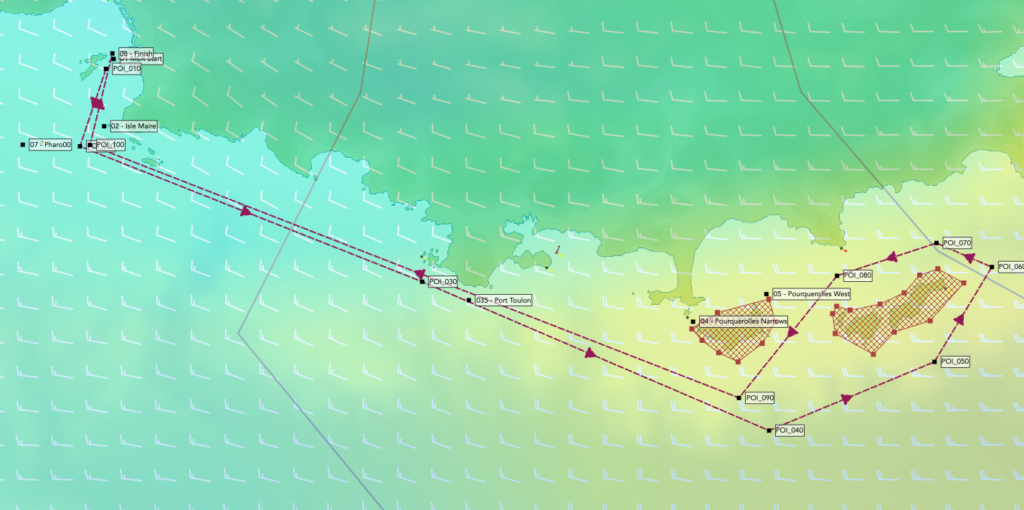
Date: December 26, 2023
Passage: Marseille Vieux Port out around Isl De Levant and back to Marseille.
Distance (Map): 70 Nautical Miles (NM) out and back for a total of 140NM or 150 statute miles. To translate NM to Statute, multiply NM by 1.151) 🙌🏻
Estimated Time: Average 4 knots x 140 = 35 hours. Using 4 knots as a low estimate as the wind looks generally 6-15 knots with a lull overnight.
Weather (WX): Looks like a perfect window. Departing Tuesday, wind 10-15 knots blowing from the west. (For weather purposed wind direction is expressed per the direction it’s blowing from.) Wind is forecasted to diminish do a 180 overnight, picking up to 10-15 during the ride home on Wednesday. The area is currently in a high pressure zone with a whopper low heading up to the north approaching the Bay of Biscay. This low is pulling the wind up from the Mediterranean across France. In the winter and spring the waters around Marseille and the Gulf of Lyon are often smashed by the legendary Mistral winds that rip from the north to the south and often last for days. For this trip however, the WX models suggest really comfortable downwind sailing both ways!
Food and Warmth: Zen’it is stocked with pantry items from our last adventure just a month or so ago. I picked up 3, just-add-water, flavored rice-in-a-bags. Lots of drinking water (over 6 gallons fresh and the house tank is 80% full as well.) Snickers and Moroccan Oranges are my go to snacks. The weather is looking super clear with overnight low temperatures of around 8 and afternoon highs about 20. I’ve got lots of warm gear, a couple jackets and a full foul weather kit, jacket, salopettes (word for marine overalls, usually waterproof), extra glasses and sunscreen. I love checklists and rather than bore you here with the exact provisioning, I’ll leave for the record, that I was well prepared technically. 🙂
Setting Out
Or ‘Last call if you want to change your mind.’ Mostly adrenaline fueled to ensure that I not only get underway but that I ‘make way’. I subconsciously consider a smooth depart from the dock as the last piece of the ‘Factor 1’ checklist. Factor 1, according to the Annapolis Book of Seamanship, is the key ingredient in the Formula for Disasters at Sea. It states that, “A rushed and i’ll considered departure” is first on the list – as it turns up in most sailing disasters.
My small boat is named, “Zen’it”. She’s a Beneteau First 31.7 racer/cruiser. She shares the same hull designed by the Finot Group as that found on the famous first generation of Figaro offshore racing sail boats, the platform of choice for upcoming offshore solo racers in France and the UK. It has it’s own series, like the minor leagues where you hone your skills and attract sponsors while aspiring to level up to the Open 40s or IMOCA boats. Zen’it has a decent but aging sail plan. She is in great shape and lives in the Vieux Port in Marseille in the Winters and goes on the hard for the summer in Port Corbières, about 5 miles up the coast.
In Marseille they ‘Med Moor’ – butt to the dock and squeeze in between your neighboring boats. My space is so tight that I can manually push and pull against my neighbors to get into the narrow channel between the dock plannes.
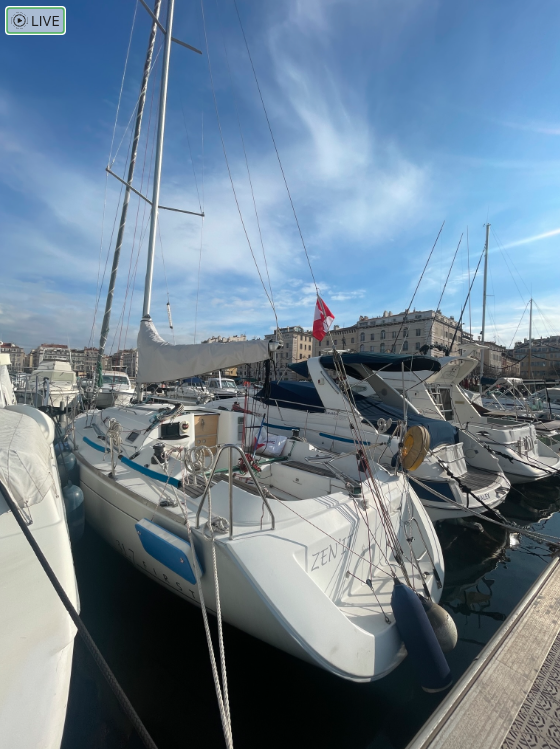
That said, all goes well. Abiding by Rule 1, the slower going in pilotage, the smaller the crash. Lol. I leant that from Eryon, who was my first sailing mentor in France the first time I crashed into a dock.
Filled with excitement and an equal amount of trepidation, I am feeling quite satisfied for getting out of the harbor with some degree of grace. (It might sound silly but solo pilotage in and out of the harbor is typically the most stressful part of the trip.) For some reason heading out of the old port possesses me with the desire to take all kinds of pictures and videos and to send them to my friends and family. It’s a historic old port and it’s really beautiful but there are also navettes, ferries, fishing boats, sailboats, pilot boats, rowers and all kinds of traffic – need to pay attention!
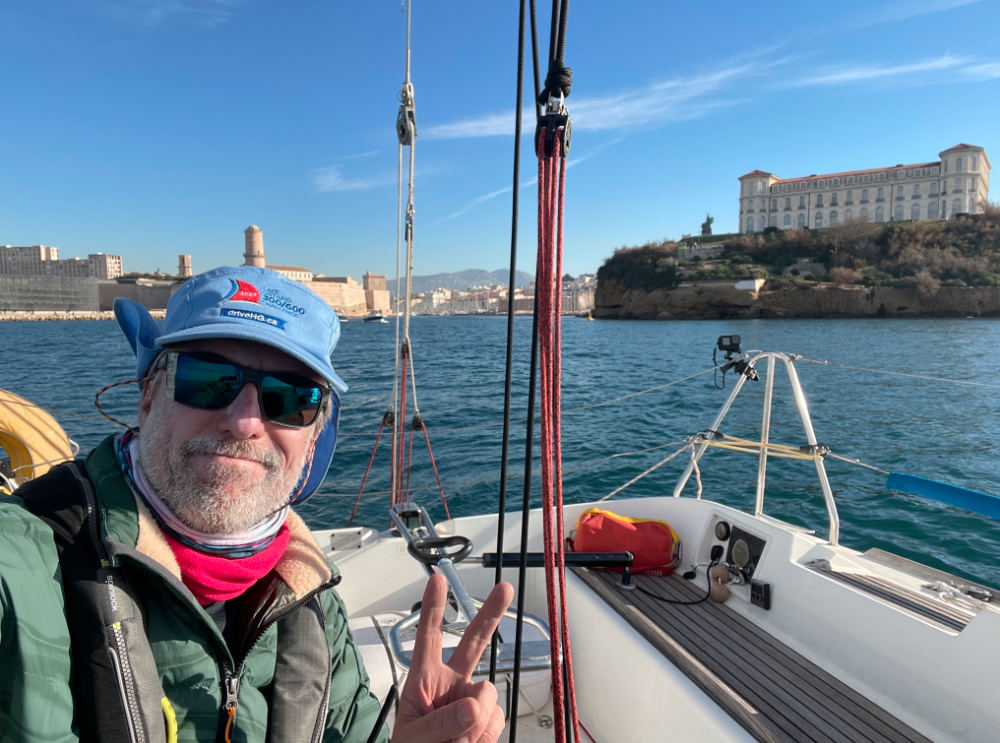
This is also my time to recount the “What If” list for the umpteenth time. My route, as somewhat dictated by the weather, is taking me a bit offshore to catch a long broad reach, downwind leg that should last until dark or so at which point the wind is planned to stall and drop to 3-5 knots then do a complete 180, ideally, just about when I get to Isl de Levant to turn around.
The further from land the more I recite the ‘What If’ list. It starts with the following Big 3:
1. The Keel Falls Off – Unlikely as Zen’it was previously in an accident with the past owner who had the keel totally rebuilt, stronger, faster and smoother… I hope.
2. Rudder Falls Off – Well, that would suck. Paul’s advice includes using lines tossed astern to essentially drag steer the boat by moving the dragged line to the port of starboard side of the boat. Next idea would be to use a table leaf tied to the spinnaker pole (or a floor cover would work as well). Actually, I really need to think more about this….
3. I get a blood clot to the brain, heart or lung – also, obviously sucks. Nothing I can really do outside of make an attempt at distress signals if I am conscious enough to do so. This is also unlikely and I am taking blood thinners.
Most other things from catastrophic rig failure to fire are manageable to the extent that I’ll likely live with varying degrees of damage to self and/or vessel. These include; electronic failure, auto-pilot failure, boom to the head, slip/fall, storm/unmanageable wind or waves, running into something or another vessel, and the worst I guess, falling overboard.
As the shoreline fades into the distance and things settle into a groove, it’s time to make some coffee. Pierre would be disappointed with my victualization – It’s only instant coffee on this trip…
The Groove
Having sorted out the fact that good luck is not a bad thing, I get into the joy of the scene. The scene being the routine and wonder of it all. The routine, to me, is the slowly dispersed pay back of the debt borrowed for said good luck. It includes a way of doing things and thinking that acknowledges thoughtful seamanship and a practical cadence of activities that offer a structure to things while the rules on land fade away.
I have decided to make a log entry hourly, reminded by a rater annoying pair of minuterie du cousines or egg timers as we would call them in English. The log, I think still a legal requirement for long or commercial passages, is also a requirement for the GLSS and the Lake Ontario 300 solo race – but mostly it’s a chime to snap to attention and see what has been going on since the last entry. It’s a bit subjective what to log but the constants seem to be; wind speed, wing angle, course over ground, course steered, barometer (pressure), location (Lat/Long), battery charge level (I don’t have gauge but should have), bilge check, line change (every 12 hours), size, type and coverage of clouds, sea state , log and some general observation notes. (Oh, and speed over ground!)
Logging is more than recording telemetry, it’s a reminder of the overall plan, status of the boat and it makes me think of the all the journeys of ships, logged over the centuries. If you are ever in Marseille near the old port, I recommend stopping in to visit la Société Nautique de Marseille where they house, in their nautical library, ancient log books of great voyages, all in elegant script.
At times annoying, especially when tired, or if nothing has changed, the log is the legal document of the voyage and in a funny way, confirmation of discipline on board.
My log book is a red leather bound log, a prize I won for 2nd place, Champion of the Mediterranean, First 31.7 Design, Solo Class. I was 1 of 2 participants.

There is a unique, not quite discomfort, more like an unfamiliar bumping into yourself, that happens after the course is set, sails are trimmed and les gréements are in order. It’s when you break the ice with yourself and welcome yourself to join in this space where wit, wisdom and a sense of humor are ideal attributes.
I am wondering where my thoughts are coming from. Can I plan what I’ll think next? What should I do with what I think next? Let’s try some extremes – Should I just jump overboard? What difference would it make? Are there really giant squids that no one talks about much, that have a penchant for small boats and boney sailors? Just what do I actually make of it all? I could use a new name. I sure hope this bit of fiberglass, aluminum, ropes and wires is going to hold up. Things take on an interesting philosophical twist and I think of Christian Williamson, one of the first YouTube solo sailor folks I tuned into. I resonated with his curiosity and seamanship. The following is an excerpt that seemed apropos, from his book titled, The Philosophy of Sailing.
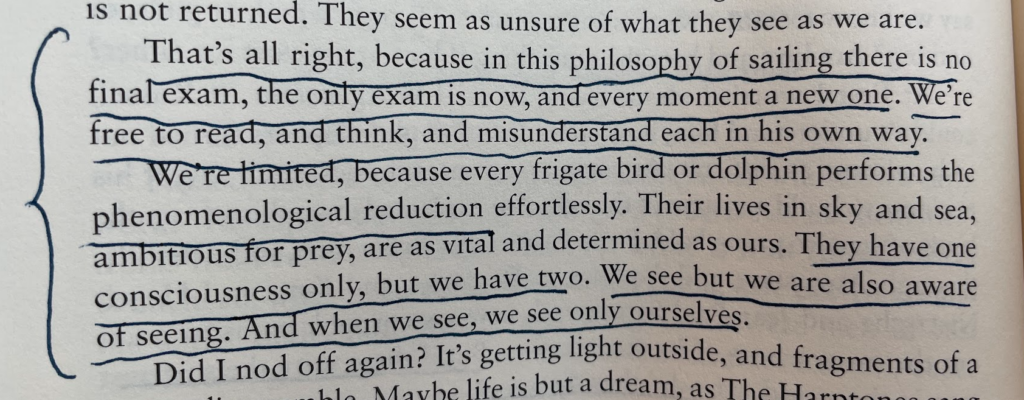
Man, these waves are getting big…. Or are they? When did I last eat? How is my Mom doing? DIT DIT DIT DIT…. That’s the alarm – time for a log entry.
Night Transition
Ok, me, myself and I are just too wired as hopeful optimists to end it all in a moment of existential reckoning and I love my boat too much to harm her, plus – I am more afraid of being in the water than death itself. Thus I believe I’ll make a competent sailor!
Night sailing commenced. I am lucky to witness a simultaneous sun set AND moon rise. Time to check the weather, chafe, deck check, make some extra coffee in thermos, pop some Snickers into my jacket pockets. Plan for the worst, hope for the best.
I turn on night mode on the iPad. Its running QTVLM with waypoints and an AIS overlay, connected wirelessly via a WiFi MiniPlex router. It has a second screen providing a custom dashboard for key telemetry. It’s also a good time to connect my small Bluetooth speaker to my phone to kick off an evening soundtrack.
Now that most key decisions have been sorted out I work on some jokes, mostly wordplay and an assortment of what options I would choose as a new name. Some tunes if you please….
The transition into night includes a serious evaluation of sail plan, course and assessment of ships and any land masses that might be encountered over night. It’s dark here at 5pm and it wont be light until 7am. Quick change into warmer clothing and a mental run thru of the reasonably managed ‘What Ifs’. Thinking thru reefing workflow, second ratio check just in case, what are my bailouts and safe harbors. Navigation lights on.
I have been lucky to have done this before but with other teammates and mentors on board but it’s different alone. Gotta be ready mentally, no naps, all just me and the amazing Zen’it. (And some soothing sounds provided by Jeremy Sole via KCRW app – no kidding – the speaker is playing a remixed version of Sailing by Christopher Cross. That’s uncanny.
Deep Night
Funny moment, I actually yell at my boat, “Are you f*cking serious??” when my foresail gets caught around the pulpit nav lights during a midnight gybe. The funny part being that I wonder if I was too harsh with my profanities. I don’t want to hurt Zen’its feelings. The foresail is a J1 or J2, I don’t really know, but the foot is about 30-40% more than the distance to the mast. It’s been just the right size for the journey so far. I am slightly tired but mostly annoyed that I have to get up and go to the foredeck to sort it out. Waves are lumpy now, mixing the 2 footers that have been coming from the west all day with the 2 footers coming from the east and it’s forthcoming winds. The waves are totally manageable, just enough to jostle things around. It crosses my mind that it’s still early and this is nothing to be annoyed at. Just do what needs to be done the moment it needs to be done. I notice that I am starting to have micro procrastinations.
I reach to create some jokes but instead my mnemonic for establishing vessel ‘stand on’ priority enters my head. I use this – Only New Rods Catch Fish So Purchase Some
Only – Overtaken vessels, narrow channels and traffic separation schemes
New – NUC – Vessels Not Under Command – due to extraordinary circumstances
Rods – RAM – Vessels Restricted in Ability to Maneuver due to her work
Catch – CBD – Vessels Constrained by Draft
Fish – Fishing or Trawling
So – Sailing Vessels
Purchase – Power Vessels
Some – Sea planes , WIG
The above is the pecking order of what types of vessels have to get out of the way of other types of vessels with a vessel being overtaken giving way to no one.
This will be on my upcoming Yacht Master Offshore Theory test. This section also includes boat lights and day shapes as well as sound signals for situation of restricted visibility.
I have no idea where that came from but it got me back into a better mood. Double clipped in on the way up to the pulpit and back. Easy fix. Just needed to overcome my lack of inertia. One long blast follow by two short blasts is the sound for all vessels above Powered Vessel types, as well as RAM and Fishing at anchor, to use in situation of restricted visibility. The mnemonic is Duuuuuuuuk, Duck, Duck = all the muck.
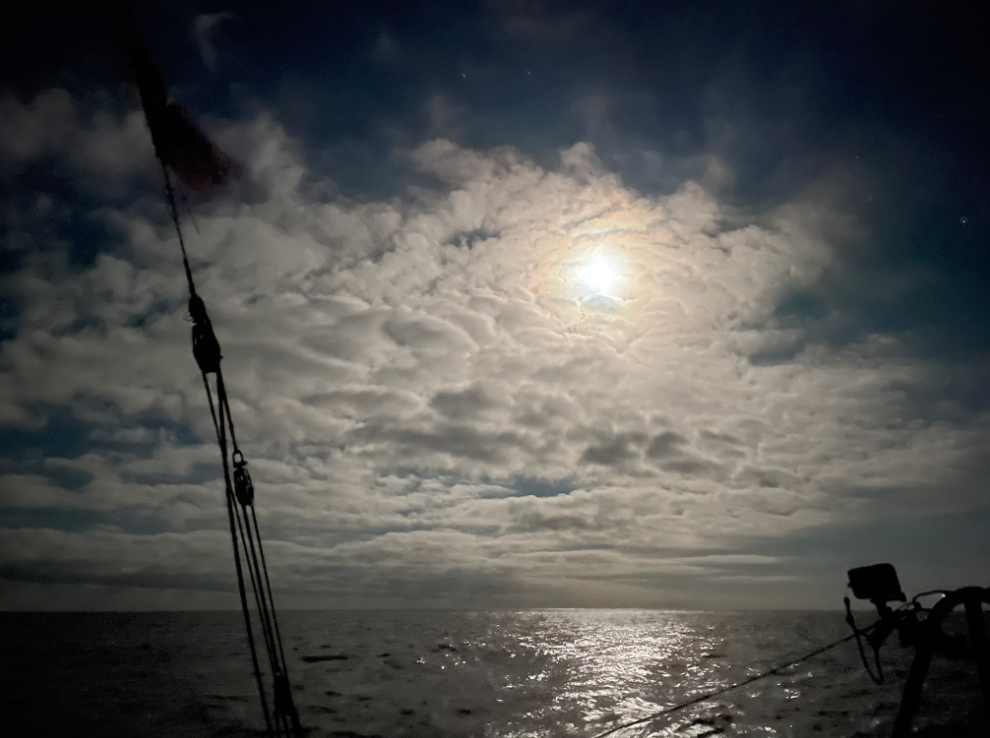
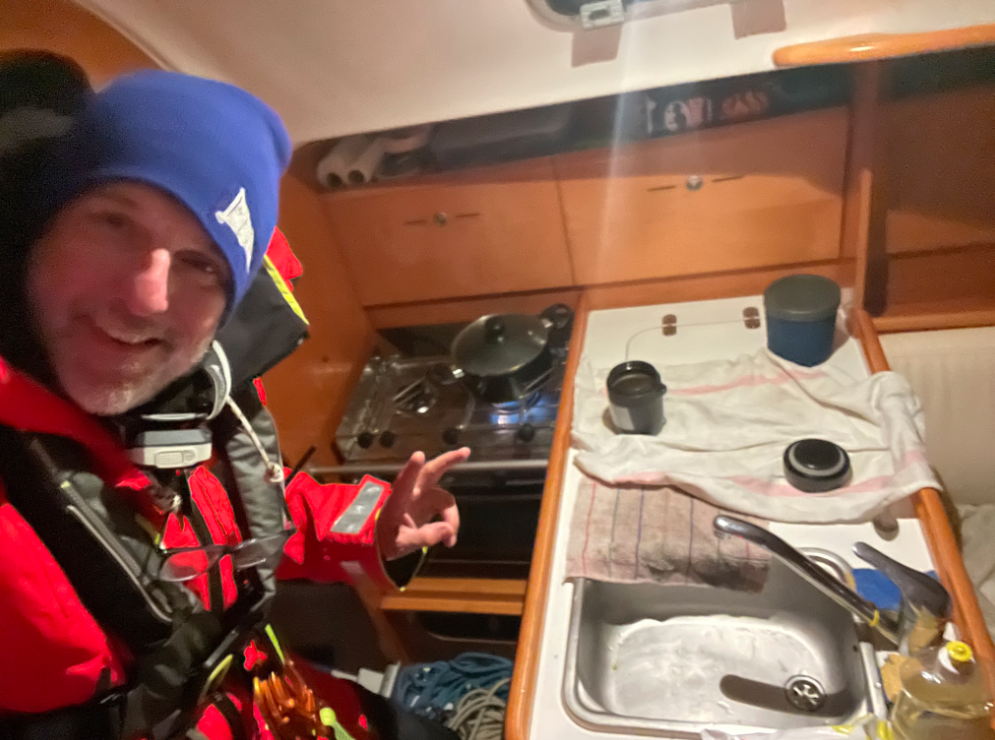

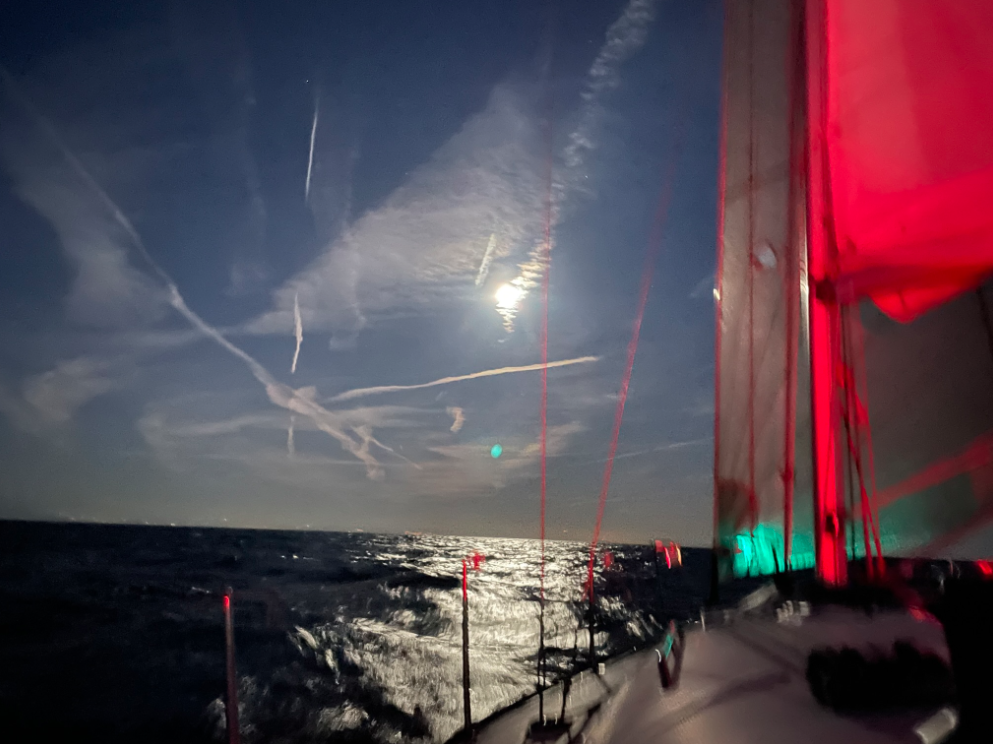
Deep night is when you are treated to the epic expanse of the night sky – always unique and full of mystery. I once was convinced that the soft purple orb I was seeing could be nothing else but a Cirque Du Soleil secret project practicing lighting effects for a new nautical show. How else could a fuzzy mauve egg shaped thing be on the water? It turned out to be a purple moon rising over what seemed to be a touchable horizon.
Lights at night play tricks on you and distances are next to impossible to measure. This is why fixed lights ashore flash uniquely – so the reference on charts can indicate which one you are observing. Some lights shine different colours depending on your bearing from the light, helping identify which is the safe side to be on and where you are in relation to the light source.
The stars are bright tonight and it’s fun to find familiar constatations. If you have a sextant and you can see Polaris, the North Star, you can actually find your latitude simply by measuring it’s altitude. You still need a dusk or dawn horizon to be super accurate. Celestial navigation is not used much anymore but it would really come in handy if I were to loose the electronics on a passage far from land. I seem to always see Orion’s Belt first.
It is now my reminder to turn on the engine to charge Bruno, my somewhat trusty tiller pilot deluxe. Actually the engine charges the house battery that powers Bruno. Bruno is very loud and he sounds like a snoring Mammoth constantly.

Daybreak
Man, what time is it? The moon is so bright it’s like daylight and it’s hard to see the stars. The wind decelerated and it has starting to swirl frenetically, spinning the wind indicator arrow on the mast head around like crazy yet we are still close hauled at 3 knots. There was a shift a few hours ago, the wind backing now from the east south east. The sails are luffing occasionally marked by the boom whip-snapping as the wind gently oscillates.
Pretty much on schedule, according to several weather models, the wind has made the move to take a pause and reconsider where it’s going to blow from on this new day ahead.
For the past few hours I have been tinkering with the QTVLM software. It’s an open source software running on my iPad that I keep in a waterproof case. QTVLM calculates your optimal sailing routes based on current weather models downloaded as GRIB files. GRIB files are essentially digital files that contains weather information in a standardized and compact form. The software factors information about your boat and sail specifications, tide and current details and it also picks up all the boat telemetry information wirelessly. Another cool feature is that is can overlay the positions of other boats nearby on AIS.
AIS is an Automatic Identification System that allows vessels to send and receive positioning and movement information so any other vessels equipped with with AIS can ‘see’ other boats on electronic charts. The AIS data usually includes the name and type of vessel and most importantly course and speed, which, when calculated, tells you if there is a chance of collision when when the collision is likely to happen. QTVLM displays a chart and all the boats on the chart that are broadcasting AIS signals. You can set an alarm to alert you when another vessel is within a certain distance. For each vessel you can see the CPA or Closest Point of Approach. This is the closest distance we’ll pass each other based on both boats current course and speed. The TCDA is the Time that point of contact will happen.
So far I have been quite investigativly occupied tracking several overtaking cargo ships heading to North Africa, a few passenger ferries lite up like floating Christmas trees in homes where colored lights are passe.
I keep the keys near the engine on a carabiner dangling from the base of the tiller, close to the ignition. The wind is so light now I need to be ready to motor if I happen to get too close to one of this giants. No close calls for me.
It’s fun to imaging where everyone is going and what cargo is on board these green triangles lighting up me screen. My eyes are playing tricks on my depth perception. The Rules say that sailboats under sail have the ‘stand on’ privilege over boats under power regardless of size however it makes sense for me to stay clear.
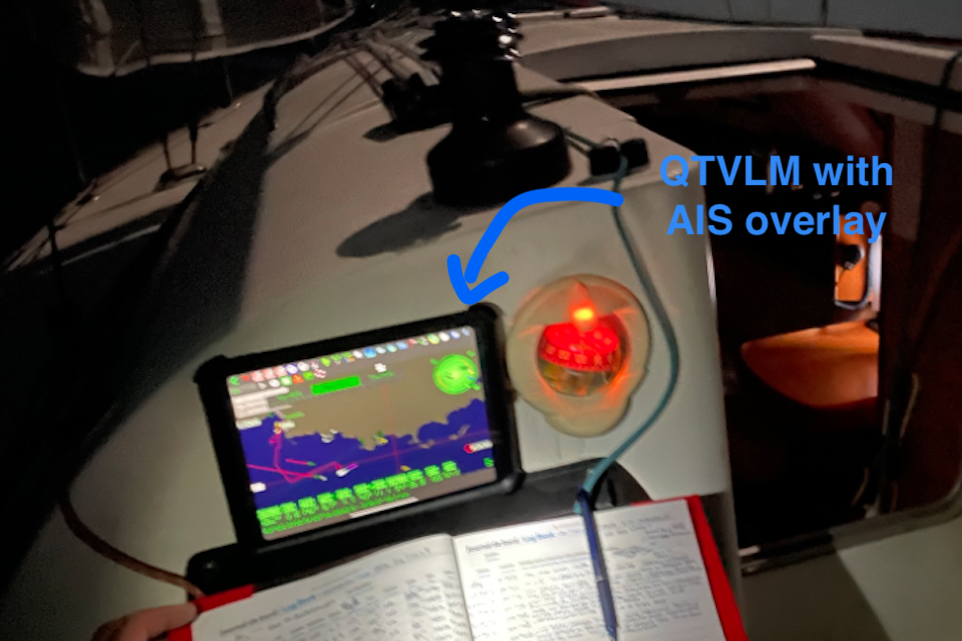
So, there are a few things going on right now. I don’t think I can get into them all in detail right now as I am currently sitting at a cafe overlooking the Vieux Port in Marseille. While I write this I am not only conscious of hogging this table but I have to get some work done on the boat before heading back to Montreal tomorrow morning. Most important is to replace the traveler car control lin cleats, these current one’s are not biting hard enough and the jib sheets have pop a few times with the traveler cars smashing aft.
The wind has completely changed direction and picked up to a steady 7-8 knots from the East
The waves have flattened as the colliding east and west sets cancel each other out. There is a distinct ‘rolling’ nature to them right now and the boat rocks in their rhythm. I am just starting to recognize how they interfere with each other and how they can help predict the winds that are coming based on the direction, size and period of the waves. Maybe only 10%, but I am getting there.
From my log, at 0649, it’s the crack of Civil Dawn. The point at which there is just enough light from the rising sun to présent a horizon line. This provides a short window for celestial navigation with the stars before the rising suns brightness makes the north disappear from view.
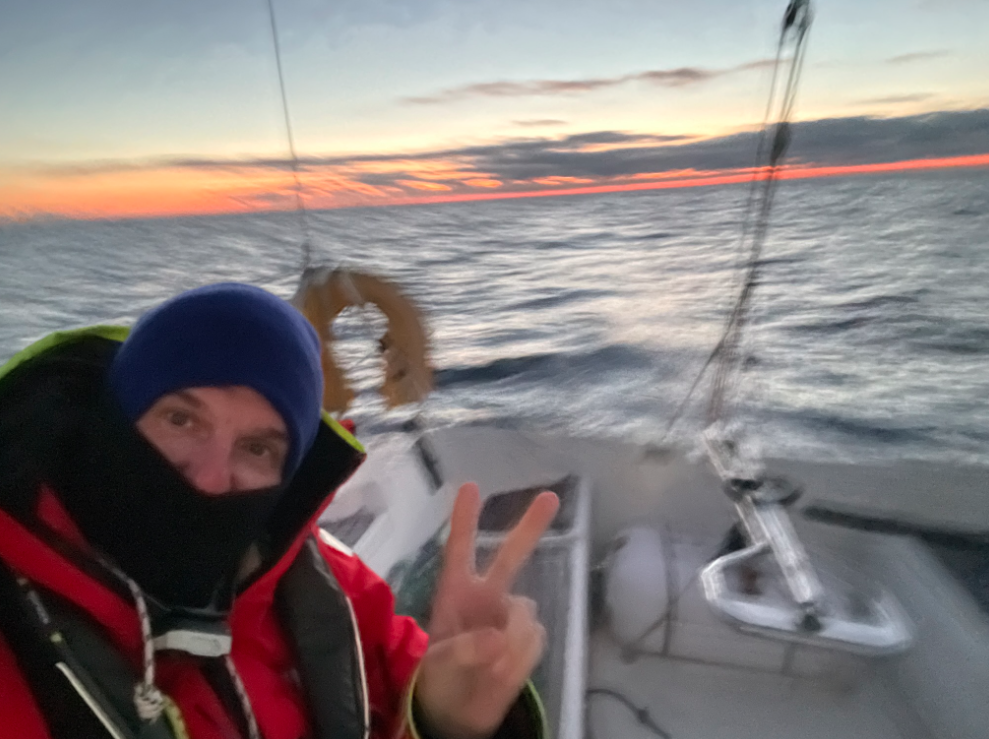
I have decided to turn around at a new virtual waypoint so creatively named, “Rounder”. I place the mark about half a nautical mile away. My log also points out that I am feeling quite tired. It’s been dark since 1800 yesterday. The original plan was circle around Ils de Levant, just after a the larger Isl de Porquerolles. We are are about 65 NM from the starting point. I wasn’t expecting so much overnight upwind sailing and we are currently 15 hours in and 72 NM travelled over ground. I prefer to get back with daylight to spare with an option to bailout in Friole Island as it’s easier to park there at the wall and have experienced the pilotage there many times.
Time to turn around and follow the setting moon positioned almost directly ahead to the west, making for a lunar guided trip both ways! The sun is now popping up as the moon sets.
The waves are now mature at 1.5-2 feet, about 4 seconds apart coming from the east. The wind is picking up, 10 knots and climbing. Barometer up from 1024 to 1027. Our speed is 6 knots on something between a broad reach and a run.
Day
At 0849 the winds have increased to 14 knots. Steadily from the east. I am downwind pinching to clear the western point of Isl Riou, after which is the 8NM home stretch and a turn to the north back to Marseille.

I can see the point but it’s still 3+ hours away. Super clear out today. At least no chance of precipitation in this big high pressure zone. Had I been paying attention to what the log was telling me, I should have put a smaller foresail up at this point. For a first solo sail the trusted J3 or even the Solent sail (a razor thin sail maybe 75% of the cut to the mast, it’s a little bigger than a storm sail.) as I know it well. There is a small tear in the bolt rope with about 1 meter to go which is important to note when raising it. Or at least a second reef in the main.
Just about 1100, ack, winds are up to 17 knots and I sense very mild panic as we hit 7 knots boat speed and 2-2.5 foot waves rolling under the port aft quarter. The approaching point is also now just an hour away and it’s likely that I have to gybe in 17 knots. The worst thing is that I really have to pee.
Arrival
There’s a funny thing that happens with distance perception and which part of land is closer to another when there are small islands in the distance. It’s around 1050 – my last log entry, and time is passing, the point at Île Marie is getting closer and I have to gybe to get some running room to get around the point.
Just when I really need Bruno to hold things together as I get ready to gybe. (I already have the main reigned in to close reach angles) and… NOTHING. Bruno stops silent. The small auto pilot control display blinks quietly, “Battery Low Warning” Sh*t, ok, um… I got 5 minutes to sort this out and I really have to pee. It would be a total mess to gybe without Bruno. I can’t turn up wind as land is directly on my right. Wind hits 20 knots.
Ok – if I start the engine it will charge the battery – but will it instantly power up the autopilot? I hope so! Transmission in neutral – yes – engine on – yes. Is she coughing out water and exhaust? Hell if I am going over there to check, nothing blowing up – so good. It’s amazing how moving 3 feet across the boat to the low side can seem like such a dangerous challenge in windy conditions. Ok let’s go. Back into position, Let’s go Bruno, prepare to gybe…
“Are you f*ucking kidding” – The display reads “Seatalk Network Error” – ARG, its frigging windy! We are now surfing at 8.5 knots. She’s not up (I am not up) for much more – Think! – Ok – Bruno is by nature quite stiff when not in use. It’s a hydraulic shaft. It’s too rigid to leave connected to the tiller when not in use. That’s perfect!! I orientate and connect the currently powerless Bruno to the tiller to hold course, still deep broad reach, surfing mode, closing in on some rocks – I figure Bruno can hold this course for about 30 seconds before the wind takes over the steering. I unclip, perform some pommel horse move from the cockpit, thru and down the companion way in one fluid motion. To the nav station, which is also home to the electronic switchboard – no time to be choosy – everything off, everything on, lots of noise as the bilge pump joins in. I scramble back to the deck, clip in – hope – hope – hope – YES – Auto pilot restarted! All systems go. Back to my crouch position, looking forward, both jib sheets in hand, one ready to pop the port side mid gybe, the other set to harden up on port tack – press 10% turn button 8 times – That should get me thru with a bit extra to spare – BOOM – Booms over, let ‘er out, trim jib – keep holding my bladder as this is just getting started….
==
So it’s really windy now, 20ish and really ripping. After that gybe we are driving away from home and the shelter of the eastern part of the bay near Les Goodes. I think I can make it past the point if I gybe soon and I HOPE the small Tiboulin island offers some shelter from this wind so I can reduce some sail. The island is bare, prickly rock but it’s probably a couple hundred feet tall so I should catch a break tucked in behind. The waves are over 3 feet now and really bouncing things about – the engine is still on, hopefully charging the battery enough to to get some autopilot support for the rest of the way home. Ready – let’s gybe back to Starboard tack now. Boom – I should clear the point this time, but I am not 100%. I generally underestimate tacks and gybes. Navionics confirms that if I hold this course I will just clear the left edge of Tiboulin island, it’s still a mile away. This is taking forever and the gusts are hitting hard now and rolling Zen’it up to the wind which is also towards the rocky point – ok – I gotta take over steering and get as far downwind as can be to clear the point.
For 20 minutes I Jedi steer, trying not to give up a single degree to the right. Trying to take back the lost degrees after each mini broach. The bigger waves seem to come in sets of three – interesting – out of control – back under control. Maybe I should just pee right now, right here, it would be warm – I literally think of Yoda – “Hold it you can…”. Feather steering – I wonder if anyone can relate to this idea of steering so zen while pinching to make a mark or clearing – This is awesome – I am shaking – scared – all senses heightened max. Wind check – 24 knots – Fark – I should have sorted the sails out hours ago at 14 knots – Am i gonna lose it?
Getting closer to the point now and I can see some fishing boats hiding out around the corner – almost there – jib is in tight as to not take on too much wind, main is out so much it’s flapping violently – the gusts hit hard, they create a hissing sound over the water now. I can only deal with a few more big gusts as we are just on the final limits of staying in control. I didn’t see this in this mornings weather forecast.
We finally round the western point of the tiny Tiboulin island. The shelter shadow on the leaside of the island is only about 100 feet before the opening on the other side and more hissing winds. Perhaps blowing harder as the gap between the island and land compresses the wind. I am shaking – I gotta get this under control now – head up into the wind in the limited shelter of the island – throw her in gear, get Bruno to take over heading directly upwind – off all things, I try to drop the foresail by popping the halyard cam – nothing happens – fark – i have fuller! We are slowly powering forward directly into the rocky island. Ack – super shaky – pop both jib sheets and reef like hell on the furling line – hell ya! Pop the vang, main sheet – grab a sail tie, pop the main halyard – ack – need to turn fast – rock approaching – I don’t even want to know the depth – mainsail flapping everywhere but it’s down – quick tie down – press, press, press, press, press (how many times was that – don’t know but we are heading away for the rock and back into open water and the wind – Bruno is back in charge plotting a course directly back to Vieux Port which is now in sight but still an hour or so away. Anything ahead? Several sailboats have followed suit and have dropped sails pointing into the wind. (Which I should have done hours ago.)
Pause, assess. The downed main is a massive mess but no longer blowing about. Still shaking it feels like I have a full body cramp. That’s new. Clear ahead – finally – I bounce downstairs and remove 4 layers of clothing. I pee for so long I have to take an intermission to check for traffic ahead. While I am down below Bruno keeps us motoring on course, past Friole island, past castle d’Ife, home of the prison in the movie, The Count of Monte Cristo, past the two welcoming west cardinal makers, Saurodarus and Canoubier, past the break wall where “Red, right, return” is the opposite, here we keep green on the right to return. I love those lights and the ancient Musée and the tall cliffs sheltering the mariners return to port.
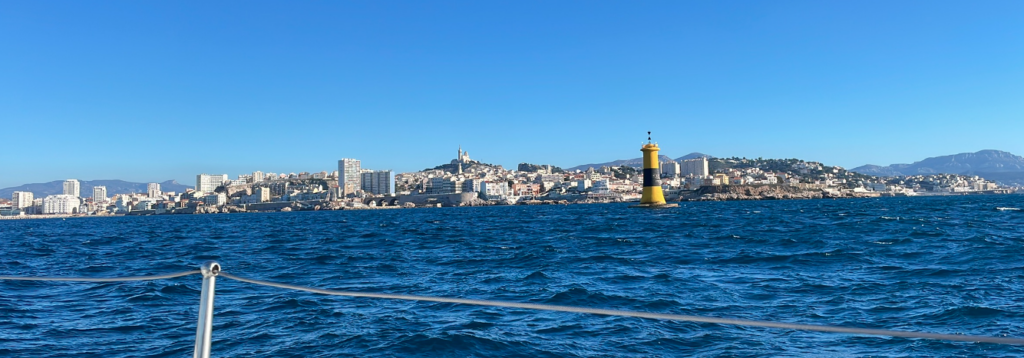
A top of everything visible along the skyline, viewed from the sea, is the towering, basilica of Notre-Dame de la Garde with a golden Virgin Mary and baby Jesus. It’s known as La Bonne Mare or the Good Mother. Mariners and fishermen have historically used it as a guiding landmark before modern beacons and it continues to be a symbol of hope and safety. Within the basilica there are many votive offerings in the forms of model boats, paintings and plaques, left over centuries by mariners thankful for safe passage and miraculous survivals at sea.
I take a few moments to look up there before tucking behind the breakwall and into the harbour to squeeze into my mooring spot.
Observations and Lessons Learned
- Looking back at the log – I should have noticed the trending increase in wind speed from 6.5 knots at 0554 to 11.5 at 0806. Especially under the conditions of a first solo sail and being tired. At least the J3 or ideally the Solent. Perhaps a second reef at 14 would have been a good idea as well.
- Really need to install the battery charge level indicator. It’s been sitting there for a year. Also update log to turn on the engine more often when relying heavily on tiller pilot. Also – It took until this trip to figure out that I can control the aggressiveness of the pilot. Bumping it down to Level 1 limited 50% of power use and it was way quieter.
- Add warming gloves to the standard checklist. It was not a major issue but had I got wet, I would have been quite cold.
- Need to practice heading into the wind and reefing fore and main until I can do it blindfolded and know each step on both sides up to the mast. My first reef was fast and great but I was full of energy in the daylight.
- I need to find some soft and comfortable place to sit/catch a nap. Bean bag? I just could not get comfortable anywhere for an extended period of time.
- Jack lines in the cockpit. I was safely clipped in all the time but there was a small gap getting into and out of the companionway where ideally I was clipped in 100%.
- I wasn’t able to get a radio check on the handheld and I suspect it was because I was unable to figure out how to switch the channels to International vs. USA. I downloaded the manual during the trip but it wasn’t until afterwards when I was back on land that I figured it out.
- The bolt rope on the J1/J2 (Big black carbon guy that I used on this trip) is getting crusty and worn. Need to get that replaced for next big adventure. Same for the Solent. The small tears get caught when raising the sail.
- Fix – stern white navigation light AND the Nav Light switch turns on both the bow sidelights AND the masthead tri lights. Should be able to control those separately.
- MiniPlex router resets randomly and the iPad will lose the NMEA signal once in a while. Not a major issue but annoying at night when tracking boats on AIS.
- Need a deck knife. I also have one on me but it would be faster to have on handy to cut away the life raft.
- Need a storm sail. Not urgent as the Solent works in 30 ish knots.
- Update traveller car control lines, they are not biting as the cam teeth have softened.
Log Entries
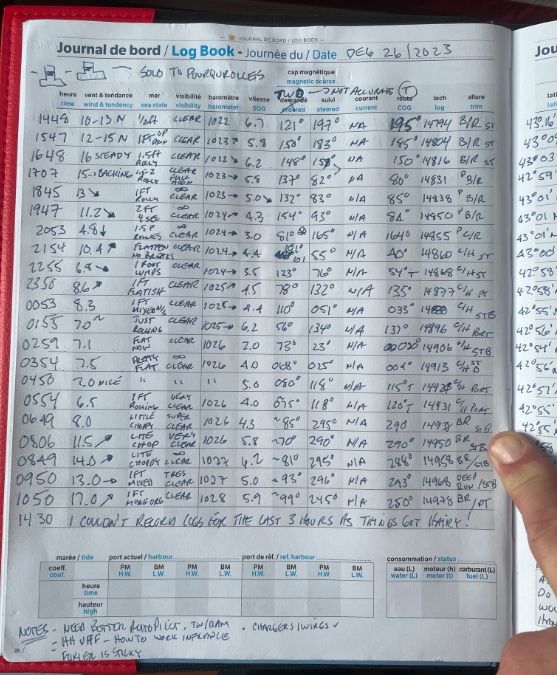
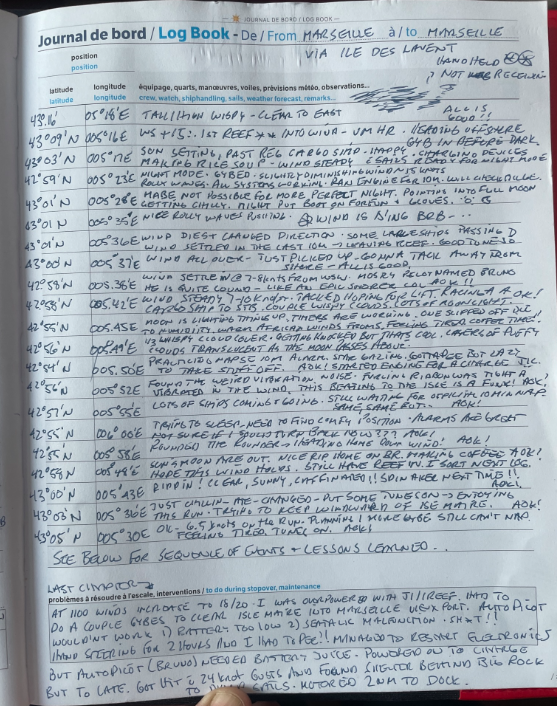
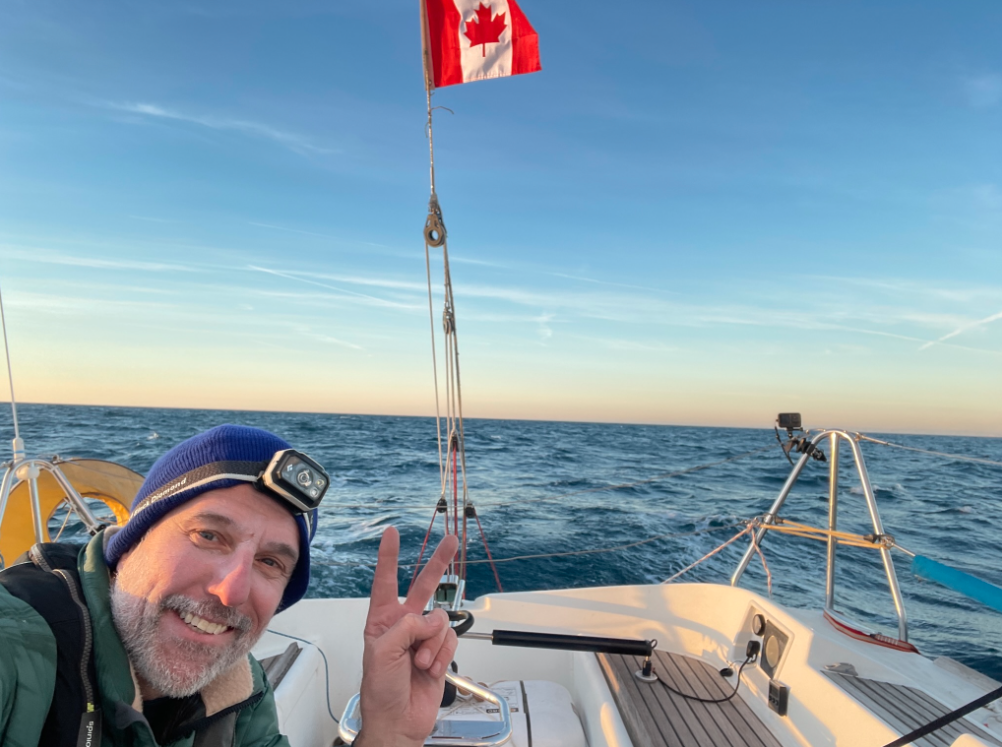
couldn’t stop reading the most detailed account i have ever read, great article, assuming you are a published author.
dave
Mate. Great adventure. Great post match analysis and take aways. Good times.
Hello